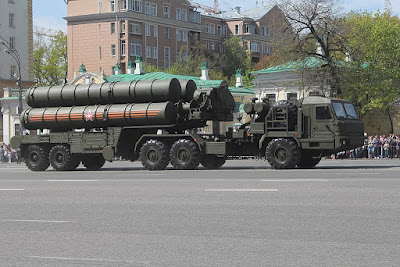The S-400 Triumf (Russian: C-400 Триумф, Triumph; NATO reporting name: SA-21 Growler), previously known as the S-300PMU-3, is an anti-aircraft weapon system developed in the 1990s by Russia's Almaz Central Design Bureau as an upgrade of the S-300 family. It has been in service with the Russian Armed Forces since 2007. The S-400 uses four missiles to fill its performance envelope: the very-long-range 40N6 (400 km), the long-range 48N6 (250 km), the medium-range 9M96E2 (120 km) and the short-range 9M96E (40 km). The S-400 has been described, as of 2017, as "one of the best air-defence systems currently made."
Development
Development of the S-400 system began in the late 1980s, and the system was announced by the Russian Air Force in January 1993. On 12 February 1999 the first, reportedly-successful tests were performed at Kapustin Yar in Astrakhan, and the S-400 was scheduled for deployment by the Russian army in 2001.
In 2003, it became apparent that the system was not ready for deployment. In August, two high-ranking military officials expressed concern that the S-400 was being tested with "obsolete" interceptors from the S-300P system and concluded that it was not ready for deployment. Completion of the project was announced in February 2004, and in April a ballistic missile was successfully intercepted in a test of the upgraded 48N6DM missile. In 2007, the system was approved for service.
Structure
The 30K6E is an administration system which manages eight divisions (battalions). The 55K6E is a command and control centre based on the Ural-532301. The 91N6E is a panoramic radar detection system (range 600 km) with protection against jamming which is mounted on an MZKT-7930. The S band system can track 300 targets. Six battalions of 98ZH6E surface-to-air missile systems (an independent combat system) can track no more than six targets on their own, with an additional two battalions if they are within a 40-kilometre (25 mi) range. The 92N6E (or 92N2E) is a multi-functional radar with a 400-kilometre (250 mi) range which can track 100 targets. The 5P85TE2 launcher and the 5P85SE2 on a trailer (up to 12 launchers) are used for launch. The 48N6E, 48N6E2, 48N6E3, 48N6DM, 9M96E, 9M96E2 and the ultra-long-range 40N6E are authorised by a Russian presidential decree. According to the Russian government, the S-400 utilises an active electronically scanned array.
Optional elements of the S-400 (98ZH6E) include the 15I6ME–98ZH6E, with coverage of 30, 60 and 90 km beyond the 30K6E coverage. The 96L6E has a 300-kilometre (190 mi) detection range. The 40B6M is housing for the 92N6E or 96L6E radar. The Protivnik-GE is an anti-stealth UHF radar with a 400-kilometre (250 mi) range. The Moscow-1 passive sensor is 2 1⁄2 times more effective than the Protivnik, with a 400-kilometre (250 mi) range Orion for a target-designation on-the-air defence system, and the Avtobaza-M and Orion+ Avtobaza adds high-precision detection. The 1RL220BE versions were reportedly were used for jamming. The 400-kilometre (250 mi)-range S-200D Dubna (SA-5c) missiles and S-300 P-family radar systems can be used without additional command-and-control centres. S-300 (SA-20A, SA-20B) missiles may also be guided. A-50 and A-50U aircraft provide early warning and command-and-control target designation.
The 30К6Е control system can be integrated with the S-400 Triumph 98ZH6E system; the S-300PMU2 (through the 83М6Е2 control system); the S-300PMU1 (through the 83М6Е control system); the Tor-M1 through the Ranzhir-M battery-command post; the Pantsir-S1 through the lead battery vehicle. The Protivnik-GE and Gamma-DE radars, integrated with the 92H6E radar system, enables communication between each battery with Baikal-E senior command posts and similar types; nearby 30К6Е, 83М6Е and 83М6Е2 administration systems; the Polyana-D4М1 command post; fighter-aircraft command post, and mobile long-range radars. The Nebo-M system is designed to hunt the F-35 joint-strike fighter. The system's VHF component provides sector search and tracking, with the X- and L-band components providing fine-tracking capability. Good placement of the radars relative to the threat axis enables the L- and X-band components to illuminate the incoming target from angles where the target RCS is sub-optimal. Attempts to jam the Nebo-M would be problematic, since all the radars have passive angle track capability against jammers; jamming permits passive triangulation of the target using three angle-track outputs. The RLM-S and RLM-D have better elevation-tracking accuracy than the RLM-M, and the Nebo M should be capable of producing high-quality tracks suitable for mid-course guidance of modern surface-to-air missiles and trajectory guidance of legacy SAMs.
The Gamma-C1E SHF mobile radar station has a 300-kilometre (190 mi) detection range. The Nebo VHF mobile radar station and the Resonance-NE radar station have a detection range of 1,200 kilometres (750 mi) and 65 kilometres (40 mi) to a height of 500 metres (1,600 ft). All Nebo-family locators are doubled for army air defence. During the 1970s, the long-range mobile UHF 5H87 and SHF 5H69 low-altitude locators were used. a 1980s goal was detection at a height of 10 metres (33 ft) at a distance of 40 km (25 mi).
For export to foreign customers, with the purpose of integrating existing customer air defence systems, additional work on improvement of the 30K6E administration system for information technology pairing with anti-kets is in progress.
sources: wikipedia
S-400 missile system
4/
5
Oleh
hanna

